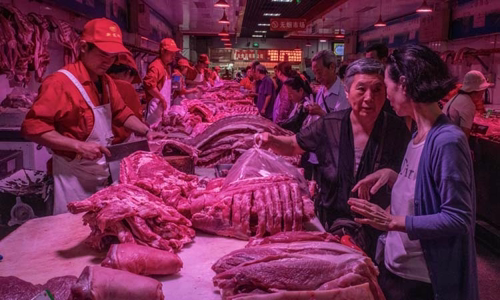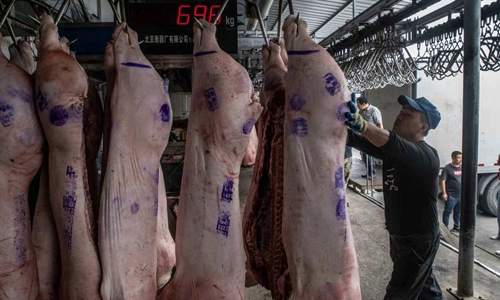After one of the pigs died suddenly three months ago, Peng Weita quickly killed the remaining 40, preventing the spread of swine fever.
However, instead of reporting to the authorities for compensation, Peng Weita buried the pigs immediately. "The investment cost in three years is nothing," said the farmer living in Wulongqiao village in northern Hunan province, China.

A wholesale pork market in Beijing, China Photo: NY Times.
Mr. Peng's loss also harmed the authorities. Because he did not report, local officials could not be sure that he had followed all the steps necessary to prevent the disease from spreading, such as disinfecting and burying carcasses away from the farm. Peng admitted to burying them quite close to his farm, but declined to give further details on the handling process of pigs' bodies before burial.
According to NY Times commentators Keith Bradsher and Ailin Tang, the African swine cholera appears to have exposed the Chinese authorities' limitations in dealing with important issues. They were confused in the process of applying top-down solutions and had to pay the price.
The African swine fever (ASF) is devastating China's livestock industry, which has the most pigs in the world, "wiping out" a third of its swine herds. The virus is harmless to humans but causes death in pigs and there is no cure or vaccine. The outbreak originated in Africa, was recorded in Eastern Europe and Russia before it first appeared in China in August 2018, then spread to many Asian countries, including Vietnam.
Preventing disease is always a difficult task. Small farms, often concentrated in crowded agricultural areas, own nearly half of China's pigs. To prevent the spread of disease, officials and epidemic workers need to reach millions of small farmers.
The process of treating cholera focused on restructuring agricultural models. With a large subsidy, Beijing has required local governments and businesses to build industrial farms that ensure safety standards, such as setting up new isolation areas for newly arrived pigs and ovens. burn sick pigs.
This solution may work in the long run, but China's embarrassment in the event of an immediate response seems to have made the situation worse.
When the outbreak began spreading 16 months ago, China's Ministry of Agriculture asked local authorities to destroy the entire pig herd if it detected only one infected animal, and at the same time compensate farmers with the highest possible rate. $ 170 for large pigs. However, before the outbreak, many had cost more than $ 250, according to government data. The epidemic caused the price to skyrocket to more than 600 USD.
In addition, in order to receive compensation, many farmers have to "cross the gate" of local governments, which do not have much budget, where officials often cause difficulties because the government only supports 40-80%. compensation costs. Officials also had to submit evidence that the pig died of African swine virus, not another disease, to receive the fee.
Consequently, the culling of pigs is delayed. Government data shows that only 1.2 million pigs, less than 0.3% of the country's total, were culled. It is not clear where the rest of the sick pigs have been taken, but experts say many more likely pigs have been slaughtered and put on the market.
This behavior will make the disease spread worse, because the virus can survive in meat for months. Australia found that nearly half of the sausages and other pork products brought by passengers into the country were recently infected, said Mark Schipp, president of the World Animal Health Organization based in Paris, France. good.
Many Chinese farmers also said they were not eager to claim compensation because they were relatively low. Peng recounted that he killed his pigs in panic and secretly buried them, so there was no evidence that the pigs were infected.

The carcasses are taken to a warehouse on the outskirts of Beijing, China Photo: NY Times.
Chinese officials also tried to reassure people by claiming to have contained the epidemic in April, July and October, but in return were signs that the epidemic was even more widespread. The Chinese Ministry of Agriculture recently admitted it only expects pork output by the end of next year to be four-fifths of the normal level.
The process of dealing with swine cholera also clearly represents an effort to meet the food needs of the country of 1.4 billion people. China has long considered food security equivalent to national security. Basically, they are self-sufficient in pork, as well as rice and wheat, with the support of the government and appropriate management of agricultural land. However, pig cholera poses challenges to the meat dependence of people in increasing demand, and has a profound impact on the world.
The surge in pork prices has made China's overall food prices last month higher than a fifth of the same period last year, after seven years of very little volatility. China's import of large quantities of pork has also pushed prices in the US, Europe and globally. Therefore, from German sausage to Vietnamese meatballs, prices increased.
The fact that households around the world are looking for alternative sources of food has led to a sharp increase in the price of beef and lamb, leading to a general increase in meat prices on the international commodity market of nearly 20% over the past year. In order to boost the production of beef and chicken to meet market demand, many Brazilian farmers have burned forests in the Amazon to get agricultural land.
"Pork cholera can have a profound impact on the economy at a global level. We don't think the world has enough pork to make up for the shortage in China," said Boubaker Ben Belhassen, commercial director. and markets of the World Food and Agriculture Organization, said.
The urgency of swine cholera is thought to be one of the factors that motivate Beijing to accept the first-phase trade agreement with Washington, thereby helping to resume US food imports. The price of pork in China has risen so much that Guangxi Yangxiang, a livestock company in Guangxi, has to hang up recruiters with the words, "Raising 10 sows to drive BMW next year."
Su Dezhi, who sells pork at an open-air market in Wulongqiao village, said he used to buy and butcher two pigs every day to sell, but now sells only half a day. The wholesale price per kilogram of pork has more than tripled.
However, Chinese consumers still do not want to eat anything other than pork. She Xinbao, who sells chicken and duck near Su's stall, said his sales were increasing from only 30 birds a day to 33-34 birds, partly because of the increase in poultry prices.
Chen Zhixiang, a 36-year-old farmer, is one of the few pig farmers in Wulongqiao who doesn't lose any pigs. He uses corn to cook rice bran instead of buying food sources at risk of virus infection from outside. Chen said local pigs were so scarce that when he drove to a village to sell pigs, the crowd immediately surrounded.
"People gathered around my truck and stared at them, as if they were watching pandas," he said.



 SonniHill
SonniHill







